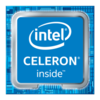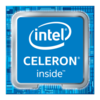Intel Core i5-8265U vs Intel Celeron N5095A vs Intel Celeron N5105
Intel Core i5-8265U
► remove from comparisonDer Intel Core i5-8265U ist ein sparsamer Quad-Core-SoC für Notebooks und Ultrabooks, der auf der Whiskey-Lake-Architektur basiert und wahrscheinlich im Q3 2018 vorgestellt wird (IFA als möglicher Termin). Im Vergleich zur Kaby-Lake-Refresh Generation, gibt es bei Whiskey-Lake anscheinend keine Unterschiede bis auf den verbesserten 14nm Prozess (14nm++ versus 14nm+). Verglichen mit dem Kaby-Lake-R Core i5-8250U, bietet der i5-8265U einen deutlich höheren Turbo-Boost-Takt. 3,9 GHz versus 3,4 GHz mit einem einzelnen Kern (3,8 GHz mit 2 Kernen, 3,7 bei Benutzung aller 4 Kerne). Ausserdem nutzt Whiskey Lake einen neuen PCH in 14nm mit USB 3.1 Gen 2 (10 Gbps) und CNVi WLAN/Bluetooth.
Die integrierte Grafikkarte hört weiterhin auf den Namen Intel UHD Graphics 620, unterscheidet sich jedoch nicht von der Intel HD Graphics 620. Im Core i7-8565U taktet sie von 300 - 1100 MHz. Weiters bietet die CPU noch einen integrierten DDR4-2400 / LPDDR3-2133 Dual-Channel-Speichercontroller sowie VP9- und H.265-Videode- und -encoder.
Architektur
Whiskey-Lake nutzt die selbe Architektur wie Kaby-Lake, welche wiederum sehr ähnlich zur Skylake Architektur ist. Dadurch hat sich die Pro-MHz-Leistung kaum verändert. Nur der gereifte 14nm Prozess verhilft zur schnelleren Taktraten und effizienterer Performance.
Performance
Die Leistung des i5-8265U hängt stark vom konfigurierten TDP, wie lange der Boost laufen darf und von der Kühlung ab. Dadurch kann es zu einer hohen Schwankungsbreite kommen. Bereits beim i7-8550U gab es sehr große Leistungsunterschiede, vor allem bei längerer Last. Wie beim Core i7-8565U ist von einer Mehrleistung von maximal 10% im Vergleich zum Core i5-8250U auszugehen.
Grafikeinheit
Die integrierte Intel UHD Graphics 620 ist laut Intel identisch zur Intel HD Graphics 620 (z.B. im Core i5-7200U). Sie verfügt wie die alte HD Graphics 520 über 24 Ausführungseinheiten (EUs). Die Performance hängt stark vom verwendeten Arbeitsspeicher ab; mit schnellem DDR4-2133 im Dual-Channel-Betrieb kann sie sich mit einer dedizerten Nvidia GeForce 920M messen.
Anders als Skylake kann Kaby Lake und Whiskey Lake nun auch H.265/HEVC im Main10-Profil mit 10 Bit Farbtiefe sowie Googles VP9-Codec in Hardware decodieren.
Leistungsaufnahme
Die Fertigung erfolgt erneut verbesserten 14-Nanometer-Prozess (14nm++) mit FinFET-Transistoren. Der TDP ist weiterhin ULV-typisch mit 15 Watt spezifiziert und kann je nach Einsatzzweck zwischen 7,5 und 25 Watt variiert werden.
Achtung: Diese Informationen basieren noch auf Leaks und Gerüchten und können sich bis zum Release in Q3 2018 noch ändern.
Intel Celeron N5095A
► remove from comparison
The Celeron N5095A is an inexpensive quad-core SoC of the Jasper Lake product family designed for use in affordable SFF desktops and laptops. It features four Tremont CPU cores running at 2 GHz that Boost to up to 2.9 GHz with no thread-doubling Hyper-Threading technology in sight. A pretty basic iGPU is present as well.
The only difference between the N5095A and the N5095 is that the former comes with support for more proprietary Intel technologies such as the Smart Sound DSP, Wake on Voice and HD Audio.
Architecture and Features
Tremont brings many improvements over Goldmont Plus, the architecture that we know from the N5030 and myriads of other N-class CPUs. An up to 30% boost in single-thread performance is to be expected thanks to smarter prefetchers, branch prediction improvements and other refinements, according to Intel. These new chips are physically larger than their immediate predecessors as a result. Either way, this is still a "small" core rather than a "big" one according to ChipsAndCheese.
The Celeron has 1.5 MB of L2 and 4 MB of L3 cache and is compatible with DDR4-2933 and LPDDR4x-2933 memory or slower. Support for Intel CNVi Wi-Fi 6 modules is baked into the chip, as are 8 PCIe 3.0 lanes for NVMe SSD speeds up to 3.9 GB/s. USB 4 or Thunderbolt aren't supported however.
Please also note that the Celeron gets soldered to the motherboard (BGA1338 socket interface) for good and is thus not user-replaceable.
Performance
While we haven't tested a single system featuring the N5095A as of Sep 2024, we have done several reviews of computers/laptops powered by the N5095. CPU performance should be pretty much identical between the two. Therefore, we fully expect the chip to be about as fast as the Core i3-10110U, Core i3-1005G1, Celeron N5105 and also the Ryzen 3 3200U in multi-threaded workloads. Which is just enough for the most basic of tasks in late 2024.
Performance will get a significant hit if the power target is set to 10 W or 6 W instead of the Intel-recommended 15 W value.
Graphics
The DirectX 12.1-capable 16 EU UHD Graphics runs at up to 750 MHz and is in many respects similar to what Ice Lake CPUs come equipped with. This graphics adapter is capable of driving up to 3 SUHD displays simultaneously; HEVC, AVC, VP9, MPEG-2 and other popular video codecs can all be hardware-decoded. AV1 and VVC can't.
As far as gaming is concerned, it is reasonable to expect playable framerates in really old games (like Dota 2 Reborn) provided one sticks to lower resolutions such as HD 720p.
Power consumption
While most N-class chips have a 6 W long-term power target, the Celeron N5095A has a 15 W TDP to mimic much faster U-class Core processors. This isn't a great CPU for passively cooled designs.
The N5095A is built with the same 10 nm Intel process as Ice Lake-U processors for pretty unimpressive power efficiency, as of late 2024.
Intel Celeron N5105
► remove from comparison
Der Intel Celeron N5100 ist ein Anfang 2021 vorgestellter Quad-Core-SoC, der hauptsächlich in preiswerten und kleinen Desktops verbaut wird. Er taktet mit 2 bis 2,9 GHz (Einzelkern Burst) und gehört der Jasper-Lake-Plattform an. Die Fertigung erfolgt im 10nm Prozess bei Intel (wahrscheinlich wie Ice Lake). Neben den vier CPU-Kernen integriert der Chip auch eine DirectX-12-fähige Grafikeinheit mit 24 EUs und einem Takt von bis zu 800 MHz, sowie einen LPDDR4(x)-Speichercontroller (Dual-Channel, 2.933 MHz, 16 GB max.). Der SoC kann nicht ausgetauscht werden, da er direkt mit dem Mainboard verlötet wird (BGA Package).
Weiterhin integriert der Chip teilweise WLAN und kann kostengünstig mit Wi-Fi 6 (Gig+) ausgestattet werden. 8 PCIe Gen3 Lanes werden vom SoC nach aussen geführt und 14 USB 2.0/3.2 und 2 SATA 6.0 Anschlüsse können verbaut werden. Das Package des SoCs misst 35 x 24 mm und ist damit deutlich größer als beim Vorgänger (25 x 24 mm).
Architektur
Die Prozessor-Architektur der Jasper Lake SoCs wurde im Vergleich zum Vorgänger deutlich weiterentwickelt. Im Schnitt soll sich die Einzelkernperformance im Vergleich zu Goldmont Plus um 30% erhöhen (10 - 80% bei den SPECint und SPECfp Benchmarks).
Performance
Durch die schnellere Architektur sollte der Celeron N5105 etwas schneller sein als der alte Pentium N5030, aber noch hinter den Tiger Lake Quad-Core CPUs zurückliegen. Der N5105 bewältigt jedoch problemlos die meisten Alltagsanwendungen (Office, Browsing) und ist auch für moderates Multitasking geeignet.
Grafik
Die integrierte UHD Graphics Grafikeinheit bietet 24 EUs (Gen. 11 Grafikkerne wie Ice Lake) welche mit 450 - 800 MHz getaktet werden. Es werden bis zu 3 Bildschirme mit 4k60 Auflösung unterstützt
Leistungsaufnahme
Der gesamte SoC wird von Intel wie der Vorgänger mit einer TDP von 10 Watt spezifiziert (mobiler N5100 6 Watt und geringere Taktraten). Damit kann der Chip prinzipiell rein passiv gekühlt werden, jedoch sind auch Varianten mit Lüfter möglich.
| Model | Intel Core i5-8265U | Intel Celeron N5095A | Intel Celeron N5105 | ||||||||||||||||||||||||||||||||||||||||||||||||||||||||||||||||||||||||
| Codename | Whiskey Lake-U | Jasper Lake | Jasper Lake | ||||||||||||||||||||||||||||||||||||||||||||||||||||||||||||||||||||||||
| Series | Intel Core i5 | Intel Jasper Lake | Intel Jasper Lake | ||||||||||||||||||||||||||||||||||||||||||||||||||||||||||||||||||||||||
| Serie: Jasper Lake Jasper Lake |
|
|
| ||||||||||||||||||||||||||||||||||||||||||||||||||||||||||||||||||||||||
| Clock | 1600 - 3900 MHz | 2000 - 2900 MHz | 2000 - 2900 MHz | ||||||||||||||||||||||||||||||||||||||||||||||||||||||||||||||||||||||||
| L1 Cache | 256 KB | ||||||||||||||||||||||||||||||||||||||||||||||||||||||||||||||||||||||||||
| L2 Cache | 1 MB | 1.5 MB | 1.5 MB | ||||||||||||||||||||||||||||||||||||||||||||||||||||||||||||||||||||||||
| L3 Cache | 6 MB | 4 MB | 4 MB | ||||||||||||||||||||||||||||||||||||||||||||||||||||||||||||||||||||||||
| Cores / Threads | 4 / 8 | 4 / 4 4 x 2.9 GHz Intel Tremont | 4 / 4 | ||||||||||||||||||||||||||||||||||||||||||||||||||||||||||||||||||||||||
| TDP | 15 Watt | 15 Watt | 10 Watt | ||||||||||||||||||||||||||||||||||||||||||||||||||||||||||||||||||||||||
| Technology | 14 nm | 10 nm | 10 nm | ||||||||||||||||||||||||||||||||||||||||||||||||||||||||||||||||||||||||
| Socket | BGA1528 | BGA1338 | BGA1338 | ||||||||||||||||||||||||||||||||||||||||||||||||||||||||||||||||||||||||
| Features | Dual-Channel DDR4 Memory Controller, HyperThreading, AVX, AVX2, Quick Sync, Virtualization, AES-NI | DDR4-2933/LPDDR4x-2933 RAM, PCIe 3, GNA, MMX, SSE, SSE2, SSE3, SSSE3, SSE4.1, SSE4.2, VMX, SMEP, SMAP, EIST, TM1, TM2, Turbo, SST, AES-NI, RDRAND, RDSEED, SHA | DDR4-2933/LPDDR4x-2933 RAM, PCIe 3, GNA, MMX, SSE, SSE2, SSE3, SSSE3, SSE4.1, SSE4.2, VMX, SMEP, SMAP, EIST, TM1, TM2, Turbo, AES-NI, RDRAND, RDSEED, SHA | ||||||||||||||||||||||||||||||||||||||||||||||||||||||||||||||||||||||||
| iGPU | Intel UHD Graphics 620 (300 - 1100 MHz) | Intel UHD Graphics (Jasper Lake 16 EU) (450 - 750 MHz) | Intel UHD Graphics (Jasper Lake 24 EU) (450 - 800 MHz) | ||||||||||||||||||||||||||||||||||||||||||||||||||||||||||||||||||||||||
| Architecture | x86 | x86 | x86 | ||||||||||||||||||||||||||||||||||||||||||||||||||||||||||||||||||||||||
| Announced | |||||||||||||||||||||||||||||||||||||||||||||||||||||||||||||||||||||||||||
| Manufacturer | ark.intel.com | ark.intel.com | |||||||||||||||||||||||||||||||||||||||||||||||||||||||||||||||||||||||||
| max. Temp. | 105 °C |
Benchmarks
Average Benchmarks Intel Core i5-8265U → 0% n=0
Average Benchmarks Intel Celeron N5105 → 0% n=0
* Smaller numbers mean a higher performance
1 This benchmark is not used for the average calculation












